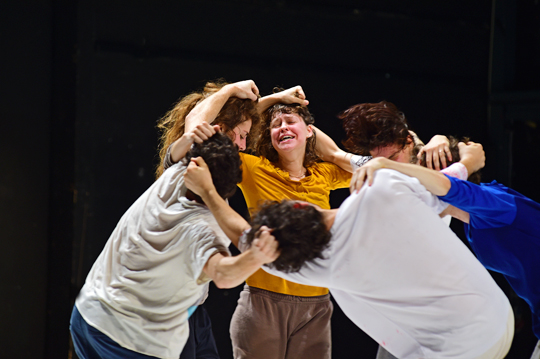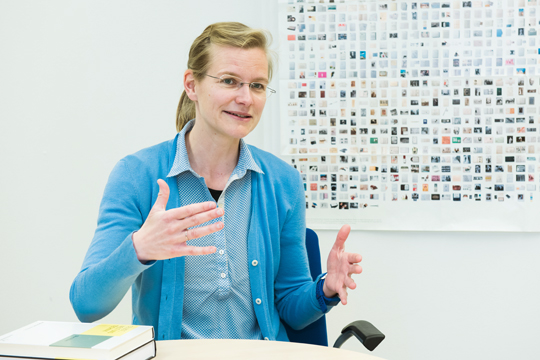Adventurous and slightly anarchic
Freiburg, May 28, 2018
How does communication between scientists and society using unorthodox teaching methods work? At the BrainLinks-BrainTools Cluster of Excellence of the University of Freiburg, a project is tackling this question: the Nexus Experiments website is situated at the interface of neurotechnological research, ethics and art. Alexander Ochs talked with Sabrina Livanec, who is in charge of conception and coordination.

For the German-Israeli project Störung/Hafraah, researchers and Parkinson patients worked with dancers, in order to explore the subject of movement and movement disorders together. Photo: Maurice Korbel
Ms. Livanec, what is your project about?
Sabrina Livanec: We develop and curate events that call for involvement in order to promote an exchange between science and the public on ethically and socially-relevant issues. To start with they draw on the neurotechnological research of BrainLinks-BrainTools. Basically however our concept is transferable to other areas. This involves us taking a special approach: we work with artists because we are convinced that art opens up a space for highly-productive interactions between researchers and society.
Who is this Internet offering designed for?
We want to reach the widest possible public with the website. We present the projects we have completed in an online exhibition, inspire thinking about neurotechnologies with survey games and provide information on current neuroscience research subjects. We also offer guidance on planning your own events, for instance for the Science Jam, an experimental and slightly anarchic format.
What sort of thing does this involve?
Imagine it’s like a test tube in which two substances react. In terms of the Science Jam, you take a scientist on the one side and an artist on the other. For instance, we had an optical researcher with a jazz musician improvising to his lecture. It’s an experiment without any fixed outcome, a playful interchange of two different areas which wouldn’t otherwise come into contact with one another.

On an equal footing: Sabrina Livanec wants to break down the asymmetric communication between experts and lay people. Photo: Klaus Polkowski
What sort of things should I consider if I want to present scientific ideas to the public?
It’s important to us to break down the asymmetric communication between experts and lay people. Then you also need the right participants on both sides, with a willingness to engage openly and on an equal footing in a more profound discussion. Naturally the formats must be suited to the audiences that you are addressing.
Can you give an example of this?
For the German-Israeli project Störung/Hafraah, junior academics and Parkinson patients worked with dancers, in order to explore the subject of movement and motor disorders together. This led to an exchange between the different participants at a level that isn’t achieved with classical forms of science communication. Another example is the project Hirn-Strips, which we offered for school pupils aged 15 and over – using comics as a format that is believed to be interesting to this group. First of all the school pupils gathered a lot of theoretical knowledge about the brain, neurological and psychiatric disorders and neurotechnological treatment options, then, under the guidance of an artist, they developed their own graphic narratives.
What special challenges are there with these kinds of teaching methods?
All sides need to have a high degree of openness and also a bit of risk-taking and courage. We have to strike the right note and create a harmonious atmosphere, depending on the target group and format. Then there are the practical and organizational aspects: How much preparation is required? What form of art, which artists, which scientists? Where will the event take place? What do we need for it? How can we attract an enthusiastic public to take part?
What tips do you have for this?
We are very precise in the choice of artists and scientists for our projects, and contact them directly. And of course it is important to use the entire repertoire of classic PR work appropriately, to draw attention to the event. It’s worth writing to associations and institutions, contacting a lot of partners and feeding information to all public channels: mailing lists, the university press office, social media, regional newspapers and the media of relevant cooperation partners.

